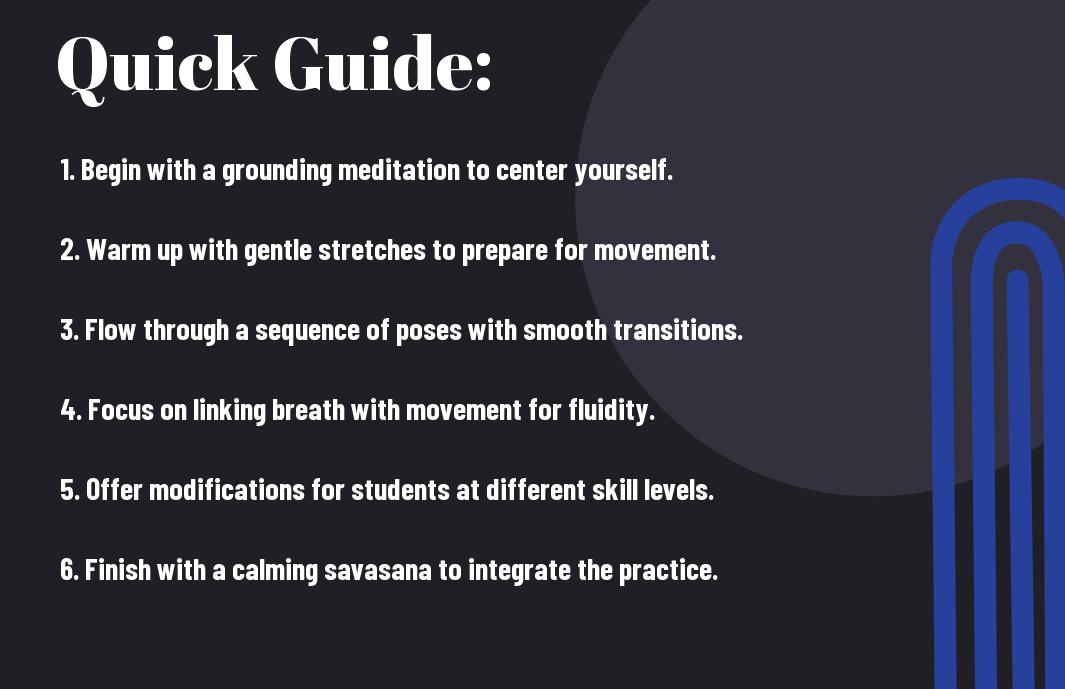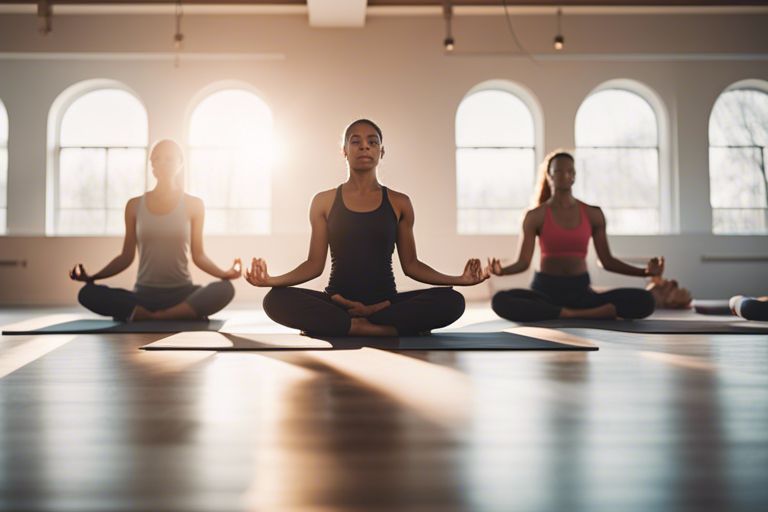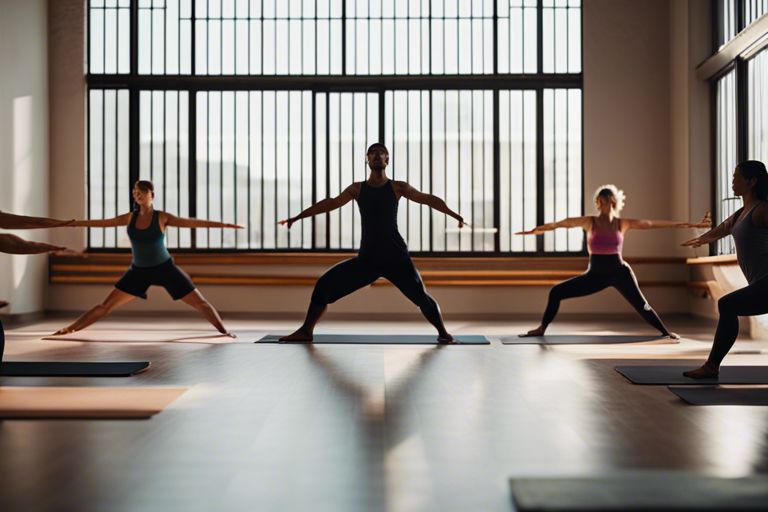Many yoga practitioners find expanding their Vinyasa practice challenging yet rewarding. This guide explores into important movements and detailed instructions to help you enhance your yoga journey and foster growth. Discover the benefits of Vinyasa yoga and explore how to refine your practice with expert tips and techniques. Elevate your yoga experience and take your practice to the next level with this comprehensive guide.
Key Takeaways:
- Focus on Breath: Paying attention to the breath is crucial in Vinyasa yoga to help connect movements with breath, cultivate mindfulness, and increase prana (life force energy) in the body.
- Sequencing and Flow: A well-structured sequence and smooth transitions between poses create a continuous flow in Vinyasa yoga practice, allowing for a seamless and dynamic movement experience.
- Alignment and Modifications: Practicing proper alignment in poses and offering modifications when needed help prevent injuries, enhance the effectiveness of the practice, and make yoga accessible to practitioners of all levels.

Understanding Vinyasa Yoga
Before venturing into the intricate details of Vinyasa yoga, it’s crucial to understand the roots of this dynamic practice. Vinyasa is a style of yoga that seamlessly synchronizes movement with breath, creating a flow between poses. It is often referred to as “flow yoga” due to its continuous and smooth transitions between asanas. This style of yoga offers a dynamic and meditative practice that focuses on the coordination of movement and breath.
Definition and Origins
Yoga has its origins in ancient India and has been practiced for thousands of years, evolving into various styles and forms. Vinyasa yoga, specifically, is rooted in the teachings of Ashtanga yoga, which emphasizes breath-connected movement and a set sequence of poses. The word “Vinyasa” can be translated to mean “arranging something in a special way,” highlighting the intentional sequencing of poses in this practice.
Types of Vinyasa Yoga
Vinyasa yoga encompasses several sub-styles that cater to different practitioners’ needs and preferences. Some popular variations include Power Vinyasa, Slow Flow Vinyasa, and Yin Vinyasa. Each style offers a unique approach to the traditional Vinyasa practice, focusing on varying elements such as strength, flexibility, and mindfulness.
| Power Vinyasa | Fast-paced and challenging |
| Slow Flow Vinyasa | Gentle and meditative |
| Yin Vinyasa | Deep stretching and relaxation |
| Ashtanga Vinyasa | Rigorous and structured |
| Rocket Vinyasa | Dynamic and playful |
- Exploring different styles of Vinyasa yoga can help individuals find a practice that resonates with their goals and preferences.
- Each type of Vinyasa yoga offers a unique experience, from intense physical challenge to deep relaxation and restoration.
- Perceiving how your body and mind respond to different Vinyasa styles can guide you in selecting the most suitable practice for your personal growth and well-being.
Benefits of Vinyasa Yoga
Physical Benefits
Benefits of Vinyasa yoga are numerous and contribute to improving physical health and well-being. The continuous flow of movements in Vinyasa yoga helps build strength, flexibility, and endurance. It also promotes cardiovascular health and weight loss. In a blog post from Lucile HR, “16 Benefits of Vinyasa Yoga That Will Take your Practice to …” click here to read more, practitioners can discover the extensive physical advantages of this dynamic practice.
Mental and Emotional Benefits
Yoga is known for its ability to calm the mind and reduce stress levels. Vinyasa yoga, with its focus on the breath and movement synchronization, enhances mental clarity and emotional well-being. It can help practitioners manage anxiety, depression, and improve overall mental health. By practicing Vinyasa yoga, individuals can cultivate a sense of inner peace and balance amidst the chaos of daily life.
Spiritual Benefits
Benefits of Vinyasa yoga extend beyond the physical and mental realms to encompass spiritual growth and self-discovery. By connecting breath with movement in a Vinyasa practice, individuals can experience a deeper sense of presence and mindfulness. This connection to the present moment fosters a greater understanding of the self and the world around them, leading to a more profound spiritual awakening.
For instance, the meditative aspect of Vinyasa yoga allows practitioners to tap into their inner wisdom and intuition, paving the way for personal transformation and spiritual enlightenment.
Essential Vinyasa Yoga Movements
Many individuals practice Vinyasa yoga to enhance their flexibility, strengthen their muscles, and cultivate a sense of inner peace. This style of yoga involves linking breath with movement, creating a flowing sequence of poses that can vary in intensity. Understanding and incorporating important Vinyasa yoga movements into your practice can help you advance and grow on your yoga journey.
Foundational Poses
Assuming a solid foundation is crucial in Vinyasa yoga. Foundational poses like Mountain Pose (Tadasana), Downward Facing Dog (Adho Mukha Svanasana), and Warrior Poses (Virabhadrasana) help build strength, improve alignment, and focus the mind. These poses are the building blocks upon which more intricate sequences are constructed.
Transitional Poses
To maintain the fluidity and grace of a Vinyasa practice, transitional poses play a vital role. These poses, such as Chaturanga Dandasana (Four-Limbed Staff Pose), Upward Facing Dog (Urdhva Mukha Svanasana), and Plank Pose, help transition from one sequence to another seamlessly. They require coordination, core strength, and mindful awareness to execute correctly.
Another important aspect of transitional poses is the incorporation of smooth transitions between poses, allowing the practitioner to maintain a steady breath and flow throughout the practice. By mastering transitional poses, yogis can create a sense of continuity and harmony in their movements, leading to a more fulfilling practice.
Advanced Poses
Advanced poses in Vinyasa yoga challenge practitioners to push their boundaries, both physically and mentally. These poses require a deeper level of strength, flexibility, and concentration to execute successfully. Incorporating advanced poses into your practice can help you develop a deeper connection with your body and enhance your overall yoga experience.
-
Poses
1. Handstand (Adho Mukha Vrksasana) 2. Scorpion Pose (Vrschikasana) 3. Wheel Pose (Urdhva Dhanurasana)
Transitional poses are often incorporated into advanced sequences to challenge the practitioner’s balance, strength, and coordination further. By smoothly transitioning between complex poses, yogis can enhance their practice’s fluidity and grace, pushing themselves to new heights in their yoga journey.
Step-by-Step Instructions for Vinyasa Yoga
Keep your Mastering the Art of Vinyasa: Yoga Tips for Beginners practice smooth and steady with these step-by-step instructions. Whether you’re new to Vinyasa or looking to refine your practice, focusing on breathing techniques, alignment and posture, sequencing and flow can help you elevate your yoga experience.
Breathing Techniques
| Techniques | Details |
| Ujjayi Breathing | Ujjayi breath is a crucial part of Vinyasa yoga, involving gentle constriction of the back of the throat to create an oceanic sound. This breathing technique helps to regulate your practice, calm the mind, and build internal heat. |
| Deep Belly Breathing | Deep belly breathing, also known as diaphragmatic breathing, involves breathing deeply into the belly to engage the diaphragm fully. This technique aids in oxygenating the body, reducing stress, and promoting relaxation. |
Alignment and Posture
| Techniques | Details |
| Spinal Alignment | Aligning the spine correctly throughout your practice is imperative for preventing injury and maintaining proper posture. Focus on lengthening the spine, engaging the core, and distributing weight evenly. |
An important aspect of alignment in Vinyasa yoga is listening to your body and making adjustments as needed. Remember that each individual has a unique body, so it’s imperative to honor your own limitations and continue to work on improving flexibility and strength.
Sequencing and Flow
To elevate your Vinyasa practice, focus on creating seamless transitions between poses and maintaining a steady flow of movement. Embrace the fluidity of Vinyasa by synchronizing your breath with each movement, allowing for a meditative and dynamic practice.
Now, explore creative sequencing by incorporating different poses and variations to keep your practice engaging and challenging. Pay attention to the pacing of your practice and aim to find a balance between effort and ease as you move through your sequences.
Tips for Effective Vinyasa Yoga Practice
All yogis, whether beginners or seasoned practitioners, can benefit from some tips to enhance their Vinyasa yoga practice. Here are some key pointers to keep in mind:
- Focus on your breath: Link your movement with your breath to create a seamless flow in your practice.
- Listen to your body: Pay attention to how your body feels in each pose and make adjustments as needed.
- Stay present: Be mindful and fully engaged in each pose, letting go of distractions and thoughts.
- Practice regularly: Consistency is key in improving your strength, flexibility, and overall well-being.
After incorporating these tips into your Vinyasa yoga practice, you will soon experience a deeper connection to your body, mind, and breath.
Creating a Home Practice
With the busy schedules of modern life, it can be challenging to make it to a yoga studio regularly. Setting up a space at home for your practice can make it more accessible and convenient. Dedicate a quiet and peaceful area in your home for Vinyasa yoga practice, with enough room to move freely. Utilize online resources, such as videos and tutorials, to guide your home practice and keep things interesting. Consistency is key when establishing a home practice, so try to dedicate a specific time each day for yoga.
Working with Injuries and Modifications
Modifications are an crucial aspect of Vinyasa yoga practice, especially when working with injuries. It is crucial to listen to your body and modify poses to suit your individual needs. Consult with a qualified yoga instructor to learn appropriate modifications for your specific injury. It is important to communicate openly with your instructor about any injuries or limitations you may have to ensure a safe and enjoyable practice.
Using Props and Accessories
Effective use of props and accessories can enhance your Vinyasa yoga practice by providing support, stability, and alignment in poses. Props such as blocks, straps, and bolsters can help you deepen your stretches and maintain proper form. Incorporating props into your practice can also help prevent injuries and allow you to explore poses more comfortably and safely.
Accessories like yoga mats, towels, and water bottles are crucial for a successful Vinyasa yoga practice. Invest in a high-quality mat to provide cushioning and grip during your practice. Keeping a towel handy can help absorb sweat and keep you comfortable throughout your session. Staying hydrated with a water bottle nearby is crucial for maintaining energy and focus during your practice.

Factors to Consider for Growth
Not only is it important to practice Vinyasa yoga movements regularly, but there are additional factors to consider to ensure growth in your practice. These factors can help you deepen your understanding of yoga and progress towards your goals.
Setting Goals and Intentions
If you are looking to grow in your Vinyasa yoga practice, it is necessary to set clear goals and intentions. By identifying what you want to achieve and why you are practicing yoga, you can stay focused and motivated. Make sure your goals are specific, measurable, achievable, relevant, and time-bound (SMART), and revisit them regularly to track your progress and make any necessary adjustments. The act of setting goals can provide you with a sense of direction and purpose in your practice.
Developing a Consistent Practice
Goals alone are not enough to ensure growth in your Vinyasa yoga practice; consistency is key. Developing a consistent practice involves committing to regular practice sessions, even when you may not feel like it. Showing up on your mat day after day, even if it’s just for a few minutes, can help you build strength, flexibility, and mindfulness over time.
Factors such as finding a suitable time and space for your practice, creating a routine that works for you, and prioritizing your yoga practice can all contribute to developing a consistent and sustainable routine.
Seeking Guidance and Feedback
Goals are not always easy to achieve on your own, and seeking guidance and feedback from a qualified yoga instructor or mentor can be invaluable. An experienced teacher can provide you with personalized instruction, alignment cues, and modifications tailored to your individual needs. Additionally, receiving feedback on your practice can help you identify areas for improvement and growth.
It is necessary to find a teacher who resonates with you and can support you on your yoga journey. Whether you attend regular classes, workshops, or private sessions, having a knowledgeable and supportive guide can help you progress in your Vinyasa yoga practice.
Final Words
So, if you are looking to deepen your Vinyasa yoga practice and take it to the next level, “Transform Your Practice – Vinyasa Yoga Movements And Instructions For Growth” is the perfect guide for you. By exploring the detailed instructions and movements provided in this book, you will be able to not only improve your physical alignment and strength but also enhance your mental focus and inner peace.
Don’t hesitate to incorporate these valuable teachings into your daily practice and see how your yoga journey transforms. Embrace the fluidity of Vinyasa sequences and the mindfulness they bring, allowing yourself to grow both on and off the mat. With dedication and perseverance, you can truly elevate your yoga practice to new heights. Namaste.
FAQ
Q: What is Vinyasa Yoga?
A: Vinyasa Yoga is a dynamic form of yoga that connects movement with breath. It involves flowing through a series of poses, with each movement coordinated with either an inhale or an exhale. Vinyasa Yoga is known for its fluid sequences and creative transitions.
Q: How can Vinyasa Yoga benefit my practice?
A: Vinyasa Yoga can help you build strength, flexibility, and balance. It also helps improve focus and concentration, as you must stay present and mindful throughout the practice. The flowing movements can also help calm the mind and reduce stress.
Q: What should I expect in a Vinyasa Yoga class?
A: In a Vinyasa Yoga class, you can expect to move through a series of poses that flow together seamlessly. The teacher will guide you through the sequence, linking each movement with your breath. Classes may vary in intensity, but all levels can usually participate as modifications are offered for different levels of experience.











